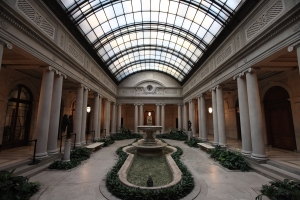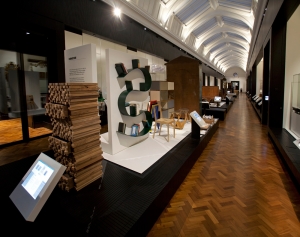|
Displaying items by tag: carving
Four rare artworks believed to have been stolen are being returned to India by an Ohio art museum.
Director Brian Kennedy recently announced that the Toledo Museum of Art made arrangements with the Embassy of India to return the objects, including an 11th-century bronze sculpture depicting the deity Ganesh and a carved stone.
The 100th anniversary celebration of the Metropolitan Museum of Art’s Asian Art department continues this month with the opening of exhibitions on Chinese lacquer and textiles.
The show on lacquer, which opened Saturday, includes works donated in March by the philanthropists Florence and Herbert Irving — among them trays, dishes and boxes, some made of carved red and black lacquer, others inlaid with mother-of-pearl or gold. Historical narratives, mythical animals and motifs symbolic of longevity and prosperity are pictured.
A selection of 100 works from the nearly 10,000 acquired during the tenure of the Shelby White and Leon Levy Director of the Brooklyn Museum, Arnold Lehman, is being presented in his honor on the occasion of his retirement in the summer of 2015. "Diverse Works: Director’s Choice, 1997–2015," on view through August 2, 2015, includes works in a wide range of media from every corner of the globe. Spanning many centuries, the exhibition brings together important objects from all of the Museum’s collecting areas.
The selections range from an ancient Chinese mythical carved figure (5th–3rd century b.c.e.) to contemporary works by Kiki Smith and Chuck Close, and a mixed-media collage (2013) in a customized frame from the American artist Rashaad Newsome.
Jeff Koons is ramping up operations at his high-tech stone workshop in Morrisville, Pennsylvania, where his sculptures are carved almost entirely by machines. This suggests that the artist may be developing new bodies of work in the medium. Since opening Antiquity Stone in 2012, Koons has more than tripled its production capacity; it now has 12 computer-operated stone-cutting machines, two robots and around 30 employees. The facility, which exists solely to fabricate Koons’s work, now bills itself as “the most advanced stone fabrication operation in the world”, according to a job advertisement it posted in January, seeking a supervisor for its Computer Numerical Control (CNC) machines.
Settled by the Dutch and claimed by the English, New York, from the start, was “a Babel of peoples—Norwegians, Germans, Italians, Jews, Africans . . . Walloons, Bohemians, Munsees, Montauks, Mohawks, and many others,” as writer Russell Shorto has observed. In the landscapes they shaped, buildings and furniture they made, New Yorkers created a place “unlike any other, either in the North American colonies or anywhere else.” This unique legacy is reflected in New York furniture featuring elaborate Dutch-inspired turnings, solid English construction methods, French sculptural carving, and Germanic painted decoration. In assembling the collection at Winterthur, Henry Francis du Pont created a world-class destination for viewing New York furniture in all of its splendid variety.

It’s time again to thank Messrs. Carnegie, Frick, Warburg, Vanderbilt, Morgan & Co. The plutocrats of the last Gilded Age left us unfathomable architectural treasures that we cherish and fight over but are still not sure how to care for. They erected houses, museums, and libraries in the form of temples and Renaissance palazzos, great hunks of ornate stone, carved wood, and intricate parquet, anthologies of precious materials and medieval craft. Some have been lost; touch what’s left and we get angry, alter them and we despair. As Manhattan keeps remaking itself, one shuttered shoe-repair store and vanished brownstone at a time, these ornate piles endure—the Frick, the Cooper Hewitt, the Public Library, the Metropolitan Museum, each with its tribe of passionate loyalists.
None of them is pristine. From the beginning, they experienced decades of fitful renovation, and their occupants still keep bursting through walls. There’s never enough space. Some institutions wear their history more lightly, or have the luxury of starting fresh.
A major exhibition titled Ice Age Art: Arrival of the Modern Mind is now on view at the British Museum in London. With works dating as far back as 40,000 years, the show presents ice age objects from across Europe alongside works by modern masters including Henry Moore (1898-1986), Piet Mondrian (1872-1944), and Henri Matisse (1869-1954). The juxtaposition is meant to illustrate the fundamental human desire to explore life and oneself through art.
Many of the ice age-era works on view are made of mammoth ivory and reindeer antler and tend to be diminutive in stature. Highlights include a 40,000-year-old flute made from a vulture’s wing bone, a mammoth tusk carved to resemble a pair of reindeer, and a 23,000-year-old abstract ivory sculpture found in Lespugue, France that had a profound influence on Pablo Picasso’s (1881-1973) sculptural work of the 1930s.
The works, which range from 10,000 to 40,000 years old, will be on view through May 26, 2013.

The Dr. Susan Weber Gallery is now open at the Victoria & Albert Museum in London. Designed by the Scottish firm NORD architecture, the gallery houses the museum’s expansive furniture collection that was once relegated to occasional displays and temporary exhibitions.
The museum’s collection spans more than five centuries and features over 200 pieces of British and European furniture as well as guest pieces from America and Asia. The V & A’s holdings are varied and include classic works by historic names like Thomas Chippendale and George Bullock as well as modern and contemporary pieces. Special attention is paid to the process of furniture making and the gallery’s display emphasizes the materials and techniques responsible for each masterpiece. The vast collection allows patrons to see how such things as joinery, turning, carving, veneering, marquetry, and upholstery have changed over the years.
Highlights on view include a 17th-century scagliola table, Patrick Jouin’s “One Shot” folding stool, which is the earliest example of contemporary digitial manufacturing, a painted Tyrolean cupboard from 1776, and a 15th-century desk-cupboard made from oak that was sources from 1,500 miles away. The new gallery also features touch-screen interfaces, short films that explain fundamental techniques, and audio commentary by furniture-makers and historians.
The gallery was funded by and named after Dr. Susan Weber, a graduate of London’s Royal College of Art. Since 1991, Weber has served as the founder and director of Bard College’s Graduate Center for studies in the decorative arts, design, and culture in upstate New York.
|
|
|
|
|